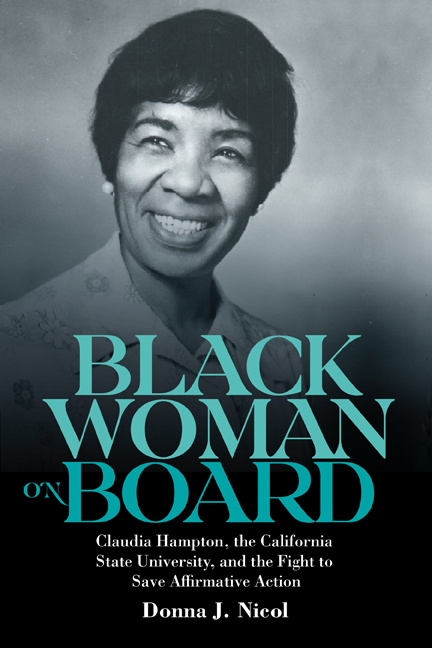 Black Woman on Board
Black Woman on Board Book contents
- Frontmatter
- Dedication
- Contents
- List of Illustrations
- Acknowledgments
- List of Abbreviations
- Introduction: A Very Fortunate Happenstance
- 1 Shifting Notions of the Public Good
- 2 Misgivings about Affirmative Action
- 3 The Conciliator Makes Dinner
- 4 A Hammer in a Velvet Glove
- 5 The Beginning of the End
- Conclusion: The Legacy and The Lessons
- Bibliography
- Appendix: Hampton’s Trustee Committee Service and Leadership
- Index
3 - The Conciliator Makes Dinner
Published online by Cambridge University Press: 09 May 2024
- Frontmatter
- Dedication
- Contents
- List of Illustrations
- Acknowledgments
- List of Abbreviations
- Introduction: A Very Fortunate Happenstance
- 1 Shifting Notions of the Public Good
- 2 Misgivings about Affirmative Action
- 3 The Conciliator Makes Dinner
- 4 A Hammer in a Velvet Glove
- 5 The Beginning of the End
- Conclusion: The Legacy and The Lessons
- Bibliography
- Appendix: Hampton’s Trustee Committee Service and Leadership
- Index
Summary
Beyond any federal and state mandates, it would take the cultivation of personal relationships with the board's white trustees by the “black woman on board” for the CSU trustees to begin to embrace affirmative action, both in principle and in practice. Within the California State University system, Mabel Kinney was the first woman appointed to the CSU trustee board in 1960. It would take another fourteen years before the board would have its first non-white woman trustee, with the appointment of Dr. Claudia Hampton. As the first Black woman board member, Hampton's appointment might have functioned as an indicator of racial equality and progress. Yet at the time Hampton was installed as a member of the board in 1974, hostile racial attitudes toward people of color were still deeply entrenched in California as in other parts of the country. Thus it should come as no surprise that Hampton's appointment to the CSU Board of Trustees was met with shock for some and open hostility from others. Claudia Hampton had to approach her work using finesse, subtlety, and shrewd thinking to counter this hostility and be effective in her role as trustee. This chapter focuses on how she enacted sly civility through a variety of strategies and tactics to protect affirmative action and push back against those forces that worked to obstruct, limit, or eliminate programs designed to increase access and equity for women and people of color within the California State University system.
In recounting the first few years of her appointment, Hampton told the story of an incident where fellow trustee board member, Wendell Witter, a managing partner of Dean Witter and Company, used a racist term during a disagreement with Hampton about affirmative action policy implementa-tion. Hampton recalled, “Wendell Witter—He was the one who made the comment in a board meeting “I don't understand this. There's a problem. There's a n----- in the woodpile.” The specific phrase Witter used, “n----- in the woodpile,” was a figure of speech used in the United States dating back to the 19th century referring to the concealment of slaves under piles of fire-wood or other hiding places. Newman Ivey White describes how the phrase eventually meant that something was suspicious or wrong.
- Type
- Chapter
- Information
- Black Woman on BoardClaudia Hampton, the California State University, and the Fight to Save Affirmative Action, pp. 90 - 122Publisher: Boydell & BrewerPrint publication year: 2024
